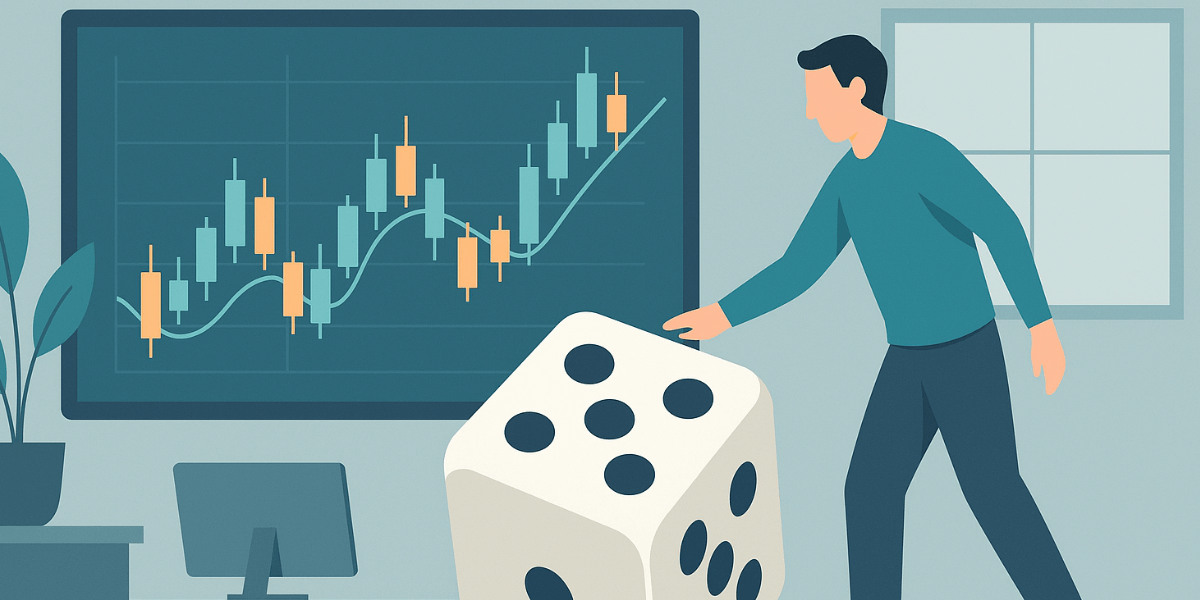Forex trading is an intricate balance between uncertainty and probability. Every decision you make—entry, stop, target, or position size—is a statistical bet on an uncertain future. While most traders evaluate risk through historical backtests or recent performance, the Monte Carlo simulation adds a deeper, probabilistic layer. It allows traders to explore a vast landscape of possible outcomes by simulating thousands of alternate versions of their trading performance, using randomization to estimate the likelihood of profits, drawdowns, and account survival.
This guide provides a detailed framework for understanding and applying Monte Carlo simulations to forex trading. We will explain how they work, how to interpret results, how to integrate them into your risk management plan, and how they can help you make peace with uncertainty—turning randomness from an enemy into a measurable variable.
Monte Carlo simulation is a statistical technique that uses repeated random sampling to estimate the probability of different outcomes in a process that cannot easily be predicted due to the intervention of random variables. In forex trading, it helps answer essential questions:
- What’s the probability of my account surviving a losing streak?
- How deep could my drawdown go under realistic variance?
- What’s the distribution of returns over 500 or 1,000 trades?
- How much capital do I need to tolerate the worst 5% of scenarios?
Instead of assuming the past will repeat, Monte Carlo explores all possible futures that could occur if similar conditions reappear. It’s a method used in physics, finance, engineering, and quantitative research to evaluate uncertainty. When applied to forex, it allows traders to quantify risk not as a single number, but as a distribution of possibilities.
Understanding Monte Carlo Simulation
Named after the famous casino in Monaco, the Monte Carlo method is based on random sampling. In trading, each trade outcome (win or loss) can be viewed as a random draw from a set of probabilities derived from your historical or theoretical system data. By reordering or resampling these outcomes thousands of times, we can observe how differently your account balance might evolve under various luck sequences—even if your strategy’s core edge remains the same.
Example:
Imagine your trading system has the following statistics based on 300 trades:
- Win rate: 45%
- Average win: +1.8R
- Average loss: −1R
Traditional backtesting will show you one equity curve—the one that actually happened. Monte Carlo simulation will show you 10,000 alternate curves generated by reshuffling the same wins and losses in random order. Each curve tells a different story: some paths will have early success, others will start with painful drawdowns. Together, they define the distribution of possible futures for your trading strategy.
Why Monte Carlo Matters in Forex Risk Management
Forex traders face not only market risk but also behavioral and structural uncertainty. Spread widening, slippage, volatility spikes, and news shocks make deterministic forecasting unreliable. Monte Carlo simulations embrace randomness instead of ignoring it. They reveal the “realistic volatility” of results you might face—not just the average but the extremes.
This has several crucial benefits:
- Probabilistic Risk Awareness: You understand not only the expected return but the range of possible outcomes.
- Drawdown Forecasting: You can estimate how deep and long drawdowns could be under bad luck streaks.
- Capital Adequacy: You can determine how much risk your account can bear without ruin.
- Psychological Preparedness: You develop realistic expectations about equity curve fluctuations.
The Core Mechanics of Monte Carlo Simulation
At its simplest, a Monte Carlo simulation consists of four main steps:
- Define the trading model: expected win rate, average win/loss, and number of trades.
- Generate random sequences of wins and losses according to those probabilities.
- Calculate the cumulative profit/loss for each simulated sequence.
- Repeat thousands of times and record key metrics (final balance, max drawdown, volatility, etc.).
By analyzing these outcomes statistically, you can estimate your risk of ruin, the probability of reaching profit targets, and even how often your drawdown will exceed a threshold like −20% or −40%.
Monte Carlo Example in Practice
Let’s simulate a trading strategy:
- Number of trades: 500
- Win rate: 50%
- Reward-to-risk ratio: 1.5
- Risk per trade: 1% of capital
If we randomly reorder the outcomes 10,000 times, we can observe the following:
- Median final return: +45%
- 5th percentile (worst-case) return: −15%
- 95th percentile (best-case) return: +110%
- Expected maximum drawdown: 23%
These numbers mean that 90% of your possible equity paths will finish somewhere between −15% and +110%. The simulation shows the “risk cone” of your results. Knowing this helps you size positions correctly and set psychological expectations.
Key Outputs of a Monte Carlo Simulation
A good Monte Carlo analysis doesn’t only produce equity curves; it extracts actionable insights. The most important outputs are:
- Distribution of Final Returns: Shows how wide your possible profit outcomes are.
- Maximum Drawdown Distribution: Estimates how bad a losing streak could get.
- Risk of Ruin: The probability of losing a predefined fraction of your account (e.g., 50%).
- Expected Volatility: The range of daily or trade-to-trade fluctuations.
- Confidence Intervals: The probability that your future results will fall within a specific range.
These outputs transform trading from a binary “win or lose” mentality into a structured probability model where uncertainty is measured, not feared.
Comparison Table: Backtesting vs. Monte Carlo Simulation
| Aspect | Backtesting | Monte Carlo Simulation |
|---|---|---|
| Data Used | Historical trades in actual order | Resampled or randomized trade sequences |
| Purpose | Evaluate past performance | Estimate future variability |
| Output | Single equity curve | Distribution of thousands of possible curves |
| Risk Insight | Average drawdown and return | Full spectrum of drawdowns and returns |
| Decision Use | Optimizing parameters | Stress-testing capital and expectations |
Designing a Monte Carlo Model for Forex
1. Gather Data
Export your historical trades with metrics such as profit/loss (in R or %), win rate, and drawdown. The more trades you include, the better your simulation represents real variance.
2. Define Simulation Parameters
- Number of trades per run (e.g., 500 or 1,000)
- Number of runs (e.g., 5,000–20,000)
- Risk per trade (% of account)
- Distribution type (fixed or variable win size)
3. Run Randomized Sampling
Each simulation run shuffles your historical trade results (or generates new ones using your win/loss probabilities). The order of wins and losses changes, producing different paths.
4. Record Key Metrics
For every simulation, calculate the final balance, the max drawdown, the number of consecutive losses, and the volatility.
5. Analyze the Distribution
Aggregate results into histograms or probability curves. Measure median, mean, percentiles (5th, 50th, 95th), and tail risk.
Interpreting the Results
Interpreting Monte Carlo results requires focusing on distributions, not single values. Here’s how to extract meaning:
- Median return: The “most likely” outcome if variance is neutral.
- 5th percentile return: Represents a pessimistic but realistic bad-luck scenario.
- Max drawdown: Defines how deep equity can fall during unlucky sequences.
- Risk of ruin: Helps set risk per trade so that ruin probability stays below your tolerance (e.g., 1%).
These statistics help you align position sizing and expectations with the real volatility of your strategy. If your simulation shows that 5% of outcomes lead to ruin, that’s a clear signal your risk exposure is too high.
Applications of Monte Carlo Simulation in Forex
1. Evaluating Robustness of a Strategy
If a trading system performs well in backtesting but fails under Monte Carlo stress (showing frequent ruin or extreme drawdowns), it’s likely overfitted. Monte Carlo separates durable strategies from those dependent on lucky trade order.
2. Estimating Maximum Drawdown
Drawdown isn’t a fixed number; it’s a distribution. Monte Carlo allows you to see 95% confidence bounds of worst-case drawdowns, giving you a better understanding of risk capacity.
3. Determining Position Sizing
By varying risk per trade in simulations, you can see how different sizing levels affect the probability of ruin or returns. This supports the use of dynamic sizing like Kelly fractions or volatility targeting.
4. Setting Realistic Profit Expectations
Traders often overestimate potential returns. Monte Carlo simulations show how fat the tails of your return distribution are—how much luck influences extreme outcomes. This brings humility and discipline.
5. Assessing Portfolio Diversification
For traders using multiple strategies or pairs, Monte Carlo can simulate random correlations between systems. This reveals whether diversification truly reduces drawdown or if correlated risk remains hidden.
Integrating Monte Carlo Results into Daily Practice
Monte Carlo data isn’t theoretical; it should influence real decisions:
- Risk Limits: Use percentile drawdowns to set stop-trading thresholds.
- Capital Allocation: Distribute capital across systems based on simulated drawdown overlap.
- Expectations: Prepare psychologically for variance—know how bad “normal” can get.
- Position Sizing: Reduce exposure until ruin probability is negligible.
In essence, Monte Carlo simulations bridge the gap between data and discipline, replacing vague intuition with probabilistic foresight.
Case Study: Two Traders, One Strategy
Trader A and Trader B both trade a 45%-win-rate system with 2:1 reward-to-risk and 1% risk per trade. Trader A’s first 30 trades happen to win often, while Trader B starts with 10 consecutive losses. In backtesting, both strategies look identical. In real life, emotional reaction and capital trajectory differ drastically.
A Monte Carlo simulation reveals that both traders are within normal statistical bounds. Trader B’s rough start is not “bad luck”—it’s an expected variation. With this understanding, he continues trading confidently instead of abandoning a good system prematurely. Trader A, meanwhile, learns that his early success is not proof of invincibility—it’s just the upper tail of variance.
Building Your Own Monte Carlo Tool
Several software packages (Python, R, Excel VBA, or trading analytics tools) can perform Monte Carlo simulations easily. The underlying logic is simple:
- Generate random trade sequences (wins/losses) using your probabilities.
- Calculate cumulative results for each run.
- Store metrics for thousands of runs.
- Visualize percentiles and drawdown distributions.
Even a simple spreadsheet can yield valuable insight. You don’t need to model every nuance; what matters is the realism of probabilities and payoffs.
Common Mistakes When Using Monte Carlo Simulations
- Using too few simulations: 100 runs are not enough; 10,000 is a minimum for stable distributions.
- Ignoring transaction costs: Neglecting spreads and slippage inflates profitability.
- Assuming constant probabilities: Market conditions evolve; re-estimate parameters periodically.
- Misinterpreting tails: Rare events matter; don’t dismiss outliers—they define risk.
- Overconfidence in averages: Median results are comforting, but tails kill accounts.
Advantages and Limitations
Advantages:
- Captures randomness and volatility more realistically than backtesting alone.
- Provides probabilistic estimates of drawdowns and returns.
- Reveals risk of ruin and tail risk under adverse scenarios.
- Enhances psychological resilience by defining expectations.
Limitations:
- Depends on accurate inputs; garbage in, garbage out.
- Assumes future probabilities resemble the past.
- Doesn’t account for regime shifts or liquidity shocks perfectly.
Conclusion
Monte Carlo simulations offer forex traders an unparalleled window into the reality of uncertainty. Rather than relying on a single backtest or a short streak of live results, you can explore the entire range of possible outcomes your strategy might deliver. By measuring not only the average but also the extremes—drawdowns, ruin probabilities, and tail returns—you create a durable foundation for capital preservation and long-term growth.
Ultimately, trading is a probabilistic enterprise, and Monte Carlo simulation is its most honest mirror. It forces you to confront variance, calibrate risk intelligently, and trade with humility grounded in mathematics rather than emotion. Used correctly, it transforms risk management from damage control into proactive design.
Frequently Asked Questions
What is a Monte Carlo simulation in forex trading?
It’s a statistical method that uses random sampling of trade outcomes to model thousands of possible equity curve scenarios. It helps estimate probable profits, losses, and drawdowns for a trading system.
How many simulations are enough?
At least 5,000–10,000 runs are recommended for stable distributions. More runs reduce noise in percentile estimates and produce smoother probability curves.
Does Monte Carlo replace backtesting?
No. Backtesting provides the raw data, while Monte Carlo explores the range of possible outcomes from that data. They complement each other.
Can I use Monte Carlo simulations for position sizing?
Yes. By testing different risk-per-trade levels, you can identify the point where expected return and drawdown balance, minimizing ruin probability.
How accurate are Monte Carlo results?
Accuracy depends on input quality. If your trade statistics are realistic and friction is included, Monte Carlo outputs will closely mirror real-world performance variability.
Can Monte Carlo handle multiple strategies?
Yes. You can simulate portfolios by combining multiple systems with different correlations to assess diversification effects.
How often should I update my simulations?
Quarterly or whenever market conditions change significantly. Re-run simulations when volatility regimes or spreads shift.
What’s the biggest mistake traders make with Monte Carlo?
Ignoring the tails. Traders often focus on median results and overlook the 5% of cases that cause ruin. The tails are where true risk lives.
Is Monte Carlo simulation useful for discretionary traders?
Yes, provided you quantify your discretionary setups and record data consistently. Even subjective traders benefit from seeing how randomness impacts their outcomes.
What’s the main takeaway?
Monte Carlo simulation doesn’t predict the future—it maps the boundaries of possibility. Within those boundaries, survival and profitability depend on disciplined risk sizing and emotional resilience.
Note: Any opinions expressed in this article are not to be considered investment advice and are solely those of the authors. Singapore Forex Club is not responsible for any financial decisions based on this article's contents. Readers may use this data for information and educational purposes only.







